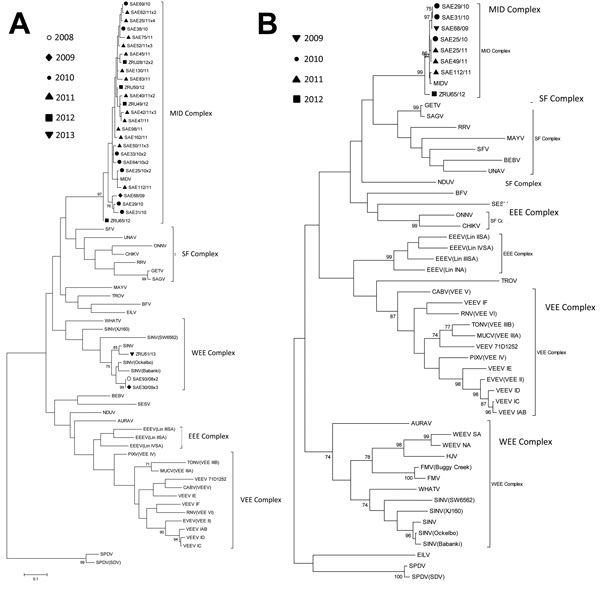Volume 21, Number 12—December 2015
Dispatch
Sindbis and Middelburg Old World Alphaviruses Associated with Neurologic Disease in Horses, South Africa
Figure 1

Figure 1. Maximum-likelihood trees of strains of Middelburg virus and Sindbis virus identified in horses in South Africa relative to other members of the alphavirus genus. Trees were constructed by using the Tamura-Nei substitution model and midpoint rooted with MEGA5 (http://www.megasoftware.net/). Scale bar indicates 0.1 nt substitutions. Estimates were constructed on the basis of bootstrap resampling performed with 1,000 replicates. Confidence estimates >70 are shown. A) A 200-bp fragment of the nonstructural polyprotein region 4 gene of MDV- and SINV-positive cases. B) A 348-bp fragment of the E1 gene of 7 MIDV cases identified in horses in southern Africa (genome position 10543–10911 corresponding with the MIDV-857 strain in GenBank accession no. EF536323). Reference sequences used in these trees are as previously described (2). Complexes are identified as follows: EEE, Eastern equine encephalitis; MID, Middelburg; SF, Semliki Forest; VEE, Venezuelan equine encephalitis; WEE, Western equine encephalitis. Viruses are identified as follows: AURAV, Aura virus; BEBV, Bebaru virus; BFV, Barmah Forest virus; CABV, Cabassou virus; CHIKV, Chikungunya virus; EEEV, Eastern equine encephalitis virus; EILV, Eilat virus; EVEV, Everglades virus; FMV, Fort Morgan virus; GETV, Getah virus; HJV, Highlands J virus; MAYV, Mayaro virus; MIDV, Middelburg virus; MUCV, Mucambo virus; NDUV, Ndumu virus; ONNV, O’nyong nyong virus; PIXV, Pixuna virus; RNV, Rio Negro virus; RRV, Ross River virus; SAE, South Africa equine virus; SAGV, Sagiyama virus; SESV, Southern elephant seal virus; SFV, Semliki Forest virus; SINV, Sindbis virus; SPDV, Salmon pancreatic disease virus; TONV, Tonate virus; TROV, Trocara virus; UNAV, Una virus; VEEV, Venezuelan equine encephalitis virus; WEEV, Western equine encephalitis virus; WHATV, Whataroanvirus; ZRU, Zoonoses Research Unit virus.
References
- Calisher CH, Karabatsos N. Arbovirus serogroups: definition and geographic distribution. In: Monath TP, editor. The arboviruses: epidemiology and ecology. Baca Raton (FL): CRC Press; 1988. p. 19–57.
- Forrester NL, Palacios G, Tesh RB, Savji N, Guzman H, Sherman M, Genome-scale phylogeny of the alphavirus genus suggests a marine origin. J Virol. 2012;86:2729–38. DOIPubMedGoogle Scholar
- Lewthwaite P, Vasanthapuram R, Osborne JC, Begum A, Plank JL, Shankar MV, Chikungunya virus and central nervous system infections in children, India. Emerg Infect Dis. 2009;15:329–31. DOIPubMedGoogle Scholar
- Weaver SC, Winegar R, Manger ID, Forrester NL. Alphaviruses: population genetics and determinants of emergence. Antiviral Res. 2012;94:242–57. DOIPubMedGoogle Scholar
- Venter M, Human S, Zaayman D, Gerdes GH, Williams J, Steyl J, Lineage 2 West Nile virus as cause of fatal neurologic disease in horses, South Africa. Emerg Infect Dis. 2009;15:877–84. DOIPubMedGoogle Scholar
- van Eeden C, Williams JH, Gerdes TG, van Wilpe E, Viljoen A, Swanepoel R, Shuni virus as cause of neurologic disease in horses. Emerg Infect Dis. 2012;18:318–21. DOIPubMedGoogle Scholar
- van Eeden C, Swanepoel R, Venter M. Antibodies against West Nile and Shuni Viruses in Veterinarians, South Africa. Emerg Infect Dis. 2014;20:1409–11. DOIPubMedGoogle Scholar
- Lloyd G. Alphaviruses. In: Zuckerman AJ, Banatvala JE, Griffiths PD, Schoub B, Mortimer P, editors. Principles and practices of clinical virology. West-Sussex (UK): Wiley-Blackwell; 2009. p. 643–68.
- Storm N, Weyer J, Markotter W, Kemp A, Leman PA, Dermaux-Msimang V, Human cases of Sindbis fever in South Africa, 2006–2010. Epidemiol Infect. 2014;142:234–8. DOIPubMedGoogle Scholar
- Sánchez-Seco MP, Rosario D, Quiroz E, Guzmán G, Tenorio A. A generic nested-RT-PCR followed by sequencing for detection and identification of members of the alphavirus genus. J Virol Methods. 2001;95:153–61. DOIPubMedGoogle Scholar
- van Eeden C, Harders F, Kortekaas J, Bossers A, Venter M. Genomic and phylogenetic characterization of Shuni virus. Arch Virol. 2014;159:2883–92. DOIPubMedGoogle Scholar
- Attoui H, Sailleau C, Mohd Jaafar F, Belhouchet M, Biagini P, Cantaloube JF, Complete nucleotide sequence of Middelburg virus, isolated from the spleen of a horse with severe clinical disease in Zimbabwe. J Gen Virol. 2007;88:3078–88. DOIPubMedGoogle Scholar
- Williams JH, van Niekerk S, Human S, van Wilpe E, Venter M. Pathology of fatal lineage 1 and 2 West Nile virus infections in horses in South Africa. J S Afr Vet Assoc. 2014;85:1105. DOIPubMedGoogle Scholar
- McIntosh BM. The epidemiology of arthropod-borne viruses in Southern Africa [dissertation]. Pretoria (SA): University of Pretoria; 1980.